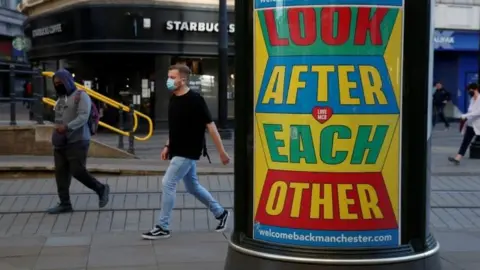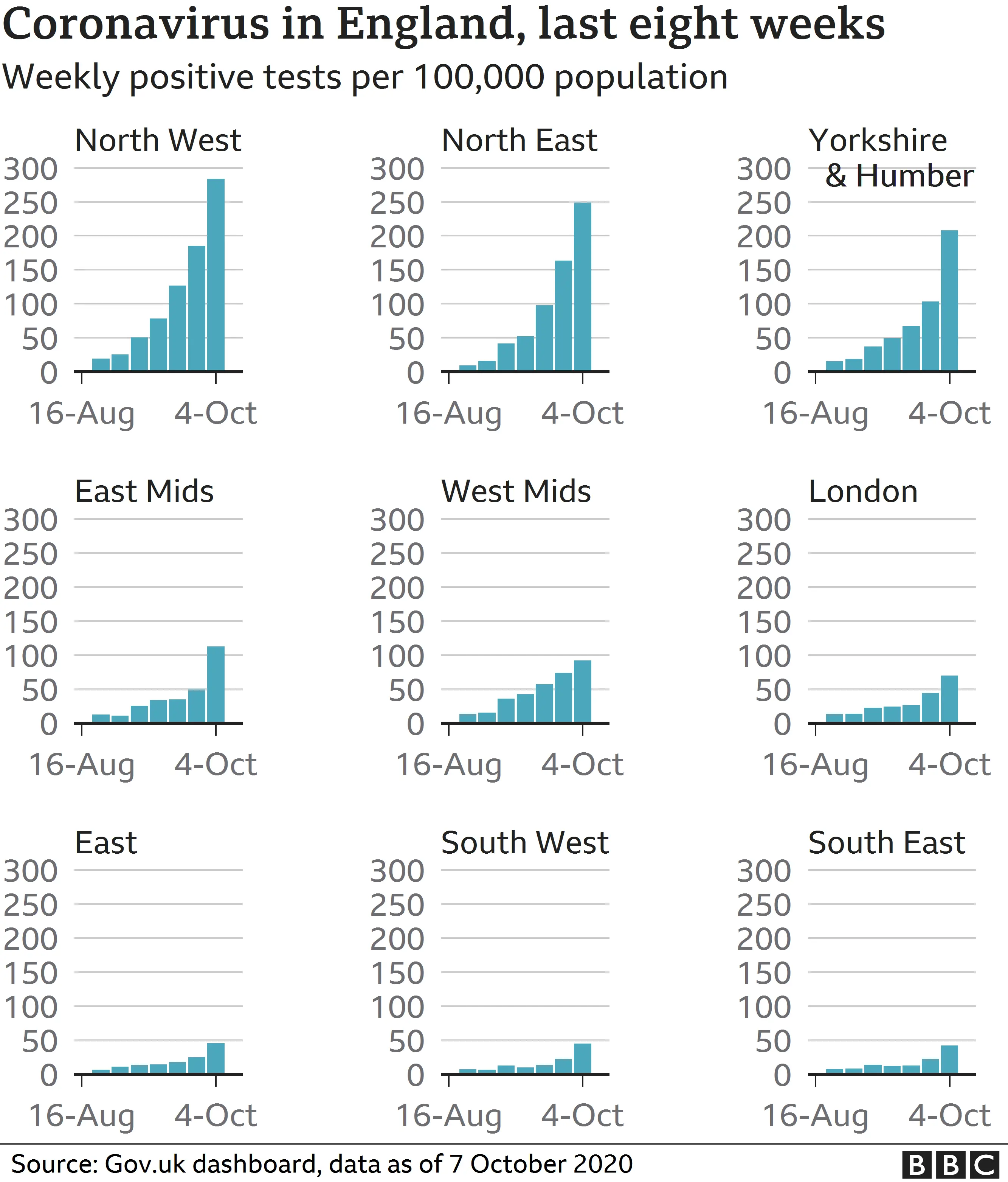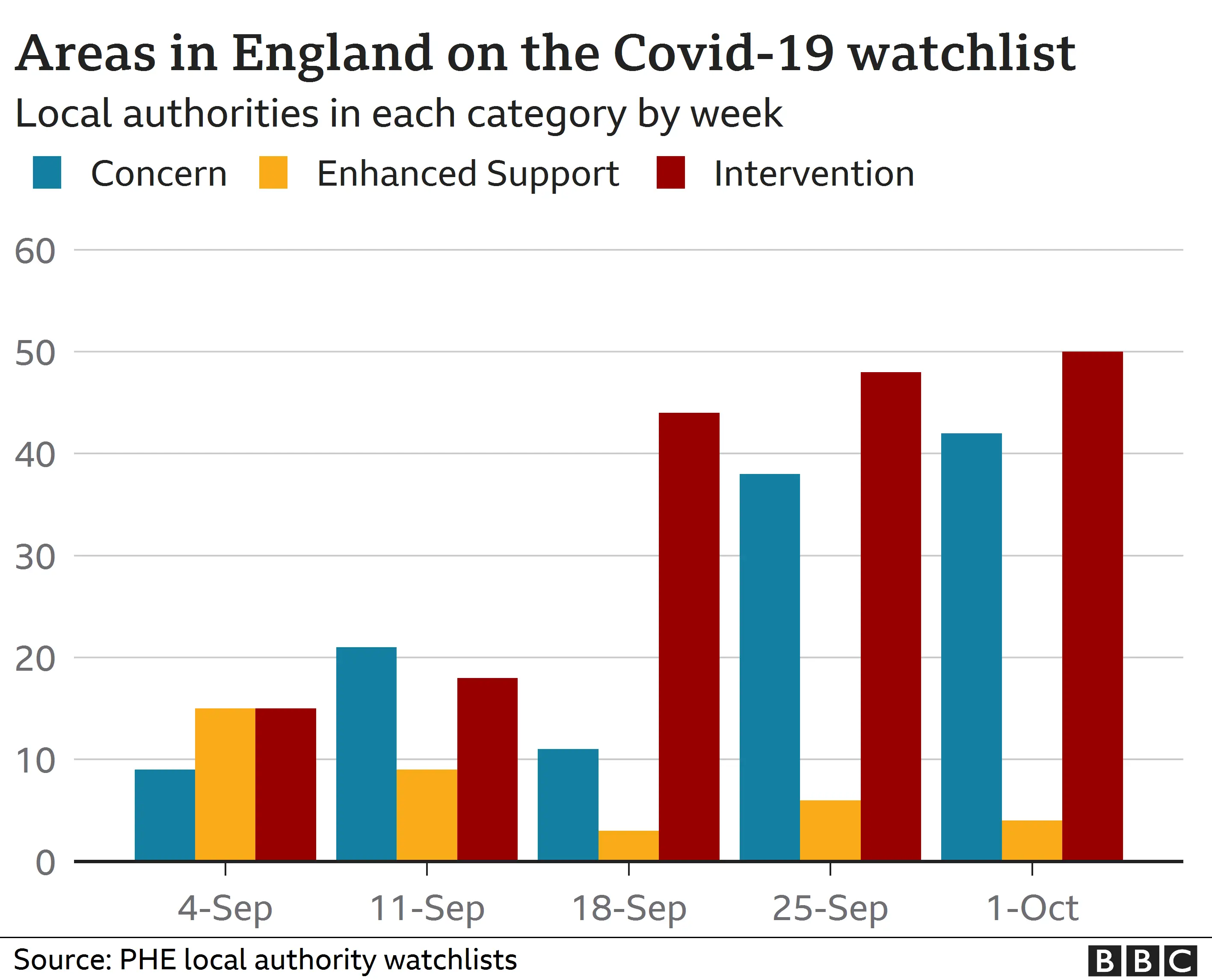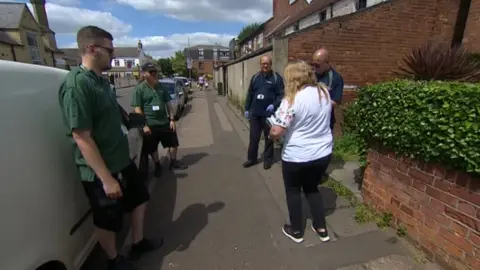Lockdown: How did some areas come off the Covid-19 watchlist?
 Reuters
ReutersAlmost 13 million people in England are living in areas under some form of local lockdown, while the number of areas on the government's watchlist has swelled over the past three months from 27 to 96.
Some, like Leicester and Greater Manchester, have been under tighter restrictions than the rest of England since the summer, while other areas have come off the watchlist altogether.
Four areas - Hertsmere, Northampton, Peterborough and Swindon - all came off the watchlist recently and officials identified three key reasons why this may have happened for them but not for others.
1) Neighbouring areas had low rates
Public health officials do not look only at the rate in one local authority area.
When Greater Manchester first went into lockdown at the end of July, Wigan was restricted even though it had low rates compared with some of its neighbours at the time.
The concern was that it was "part of a region in which overall infection rates are high, with household transmission a key infection pathway", according to the notes from the watchlist at the time.
Similarly, areas can come off the watchlist if infections are reducing and their neighbouring boroughs have low rates, even if they are higher than in other areas of the country.
That is what happened for Hertsmere, which was on the list from 11 September until 1 October as an "area of concern" - the lowest rung out of three levels of alert.
When it was removed from the watchlist last week it had 49.9 positive cases per 100,000 population.
That was higher than Wolverhampton in the West Midlands, where the rate was 49.6 per 100,000 and where people were under local lockdown.
Jim McManus, Hertfordshire's director of public health, said officials would look at the situation in nearby authorities and the wider region.

On 1 October, when Hertsmere came off the list, not only had its infection rate fallen but its neighbours St Albans, Watford and Welwyn Hatfield, also had comparably low rates.
In the West Midlands, Wolverhampton's near neighbour, Sandwell, as well as Birmingham and Solihull all had higher rates of infection and were also on the watchlist.
However, officials stress that being taken off the watchlist does not mean the threat posed by coronavirus has gone away.

What is the watchlist?
The Public Health England watchlist is published each week. Places are classed as:
- Areas of concern - the lowest level, areas with a high numbers of cases where officials are taking extra measures to tackle outbreaks
- Areas of enhanced support - where additional resources are needed to control outbreaks
- Areas of intervention - the highest level, where the spread of the virus is so significant the government usually introduces a form of local lockdown
When cases rise, the government's Joint Biosecurity Centre contacts public health teams and considers whether the area should be on the list.
Being included qualifies the local council for extra support, such as further testing capacity and establishing local contact tracing.


2) Outbreaks confined to small areas
Northampton spent eight weeks on the watchlist and has been in "intervention" - the highest alert level.
In late July the area had rising infection rates and difficulties accessing tests. This prompted a raft of measures from the district and county council to curb the virus, including local door-to-door contact tracing.
The government stopped short of imposing restrictions because it believed Northampton's high rate was connected mostly to the Greencore food factory, where there was an outbreak, rather than being spread household by household.
Lucy Wightman, director of public health for Northamptonshire, said talking to community leaders helped get information about the virus into affected areas.

"We were only just coming out of the national lockdown when our cases escalated," she said. "People were in listening mode and because of our proximity to Leicester people could see the potential implications of what would happen if they didn't take our advice seriously."
In Swindon,which was on the list for six weeks, cases had been falling for a fortnight before the area was removed.
Public health director Steve Maddern said: "Swindon had a case rate that exceeded 20 cases per 100,000, we had a couple of contained outbreaks, but had no evidence of broader community spread."
3) How high the area ranks for new cases
Peterborough was on the watchlist for eight weeks, following a rapid rise in cases in July. At the time, rates across much of the rest of England were lower.
When it was added to the list, it had recorded over 27 cases per 100,000 people in a week. While this would now be relatively low, at the time it was one of the highest rates in the country.
Even now, with more than 50 cases per 100,000 and a rise on the week before, Peterborough's weekly rate is a tenth that of the worst affected areas, such as Knowsley, Liverpool and Manchester.
Being on the watchlist gave the area better access to testing and priority for setting up local contact tracing, and the area's rate began to fall, the area's public health director, Dr Liz Robin said. It also helped emphasise the seriousness of the situation to the public.

Dr Robin said another other major reason why Peterborough came off was due to the overall national rate rising.
"We had fallen considerably down the rankings in terms of positive tests," she said.
"It was hard to justify keeping us on, as the situation elsewhere was much worse."

- SOCIAL DISTANCING: How have rules on meeting friends changed?
- SYMPTOMS: What are they and how to guard against them?
- LOOK-UP TOOL: How many cases in your area?
- SOCIAL LIFE: The rules when I go to the pub?

